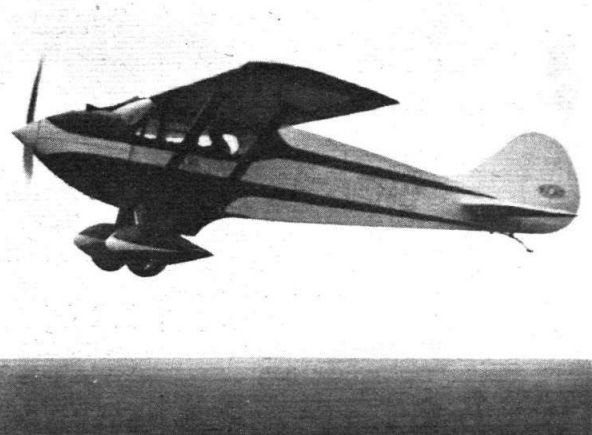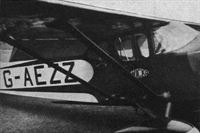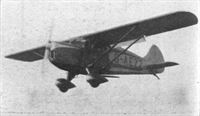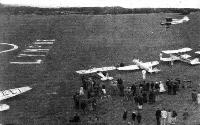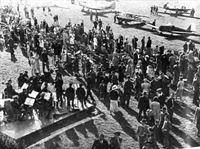Foster Wikner Wicko
Австралиец Джеффри Уикнер спроектировал в начале 1930 годов три недорогих легких самолета. В мае 1934 года он отправился в Великобританию в надежде заняться проектированием нового двухместного легкого самолета, который можно было бы поставить на серийное производство. В результате его усилий была образована компания "Foster Wikner Aircraft Co. Ltd", а на предприятии Дж.Ф. Ласти в Ист-Лондоне был построен прототип его самолета Foster Wikner Wicko F.W.1 (G-AENU), представлявшего собой высокоплан полностью деревянной конструкции, с фанерной обшивкой, стандартным хвостовым оперением, неубирающимся шасси с хвостовым костылем и закрытой кабиной на двух человек, располагавшихся плечом к плечу. Прототип был оснащен автомобильным двигателем Ford V-8 мощностью 85 л. с. (63 кВт), но после первого полета машины, состоявшегося в сентябре 1936 года, его заменили на двигатель Blackburn Cirrus Minor мощностью 90 л. с. (67 кВт), после чего обозначение самолета изменили на Wicko F.W.2.
Для участия в гонках на Королевский кубок в 1937 году был построен второй самолет - F.W.3, оснащенный двигателем Blackburn Cirrus Major мощностью 150л.с. (112 кВт). Мотор затем заменили на Gipsy Major - аналогичный двигатель стоял на девяти серийных Wicko G.M.1, построенных в 1938-1939 годах. Начавшаяся вскоре Вторая мировая война поставила на дальнейшей работе компании крест, а большая часть готовых самолетов ушла в армию, где использовалась в качестве легких транспортных и связных под обозначением Warferry.
ТАКТИКО-ТЕХНИЧЕСКИЕ ХАРАКТЕРИСТИКИ
Foster Wikner Wicko G.M.1
Тип: двухместный моноплан
Силовая установка: один 4-цилиндровый рядный ПД с перевернутым блоком цилиндров de Havilland Gipsy Major мощностью 130 л. с. (97 кВт)
Летные характеристики: максимальная скорость 225 км/ч; крейсерская скорость 193 км/ч; практический потолок 6095 м; дальность полета 772 км
Масса: пустого 569 кг; максимальная взлетная 907 кг
Размеры: размах крыла 10,52 м; длина 7,09 м; высота 2,01 м; площадь крыла 14,21 м2
Показать полностьюShow all
Flight, July 1936
NEW BRITISH CABIN TWO-SEATER
The Wicko Wizard, with Converted Ford V8 or Cirrus Minor: "Popular" Price: 120 m.p.h.
MR. G. N. WIKNER may be recalled as the designer of the Wicko Wizard monoplane built in Australia in 1934 a n d illustrated in Flight on August 16 of that year. Now, with Mr. V. Foster, he is a partner of the Foster, Wikner Aircraft Co., ol Lusty's Works, Colin St., Bromley by Bow, London, E.3, which company is constructing a new two-seater cabin monoplane to be marketed at a comparatively low figure.
Although it is laid out on strictly orthodox lines, the G.A. drawings show that the machine loses nothing in appearance. According to the designer, ease of control, stability and range of vision have been governing factors in the planning.
The wing is strut-braced and non-folding, and the tail plane a cantilever structure. A cantilever undercarriage is incorporated, the wheels being furnished with spats. In the cabin the two seats are mounted side-by-side and are adjustable fore and aft.
Normally the engine will be a converted Ford V8, known as the Wicko F. This model will be submitted for type tests at an early date. The reduction gear is a one-piece unit. Other modifications affect the ignition, water pump, generator and starter. Naturally the power/weight ratio compares unfavourably with specialised engines, but it is claimed that, for a machine of the nature of the new Wicko, this is comparatively unimportant.
With the Wicko F it is hoped to market the machine at a little under L400. The Cirrus Minor will be an alternative engine and the machine so powered will cost about L600. In this case a considerable increase in payload will follow. The main data are: Span, 31ft. 6in.; length, 22ft. 3in.; height, 6ft. 7in.; chord, 5ft.; wing area, 135 sq. ft.; weight, empty, 1,000 lb.; gross weight, 1.500 lb.; wing loading 11 lb./sq. ft.; power loading, 17.6 lb./h.p.; top speed 120 m.p.h.; cruising speed, 100 m.p.h.; landing speed, 45 m.p.h.; cruising range, 250 miles.
Показать полностьюShow all
Flight, November 1936
FORD-POWERED
The Wicko Monoplane Flies: A Cabin Two-seater with a Converted Ford F-8 Engine
ORIGINALLY described in flight of July 30 this year, the Wicko monoplane has been flying at Stapleford Abbots for several weeks. The machine is primarily interesting because it shows what can be done with an almost standard car engine, and secondarily because, by using such an engine, the price can be kept down to a very reasonable figure. How the Ford V-8 engine will stand up to this new work in its geared form, and whether owners will be prepared to sacrifice payload and range for a very considerable reduction in initial price, remains to be seen. A second machine will be fitted with a Cirrus Minor engine, and the price of this model will still be low enough to be attractive.
In its present form the Ford engine has been modified hardly at all, save for the arrangement of a double-helical spur reduction gear for the airscrew, and the mounting is rigid. In the future, rubber shock absorbers will be incorporated and there will be dual ignition, the twin plugs being fitted in Y-type adapters, which will be screwed into the normal plug orifices. A Gallay radiator is mounted beneath the fuselage with a header tank above the engine, the circulation being forced by dual pumps.
Undercarriage Simplicity
The machine itself is of very straightforward construction with a ply-covered fuselage and fabric-covered braced high wing of Clark YH section. The undercarriage is of engaging simplicity. Rigid cantilever legs are pivoted at the lower longerons, and inward extensions of these legs are held in a cradle of shock-cord.
Though arranged in the dash the throttle can comfortably be held in the pilot's left hand, while a second pilot, or instructor, could also reach it very easily. The side-by-side seats provide plenty of elbow room and each is adjustable. Naturally enough, the top of the engine cowling is high in comparison with that of modern inverted engines, but the somewhat restricted forward view is partially balanced by the excellent field of view at the side. In rain the pilot's window can be opened and held open by a catch on the lower surface of the wing.
When we visited Stapleford, visibility was a matter of half or three-quarters of a mile with a light rain and no appreciable wind. In such circumstances it would have been a dangerous waste of time to a newcomer to have attempted to take the Wicko up, but a member of the staff flew round with Mr. Wikner, the designer. Though knowing the district very well, even he got himself lost for a few minutes! The Ford engine gives something like 85 b.h.p. at 3,500 r.p.m., but, because, perhaps, of a slightly unsuitable airscrew, the engine on this occasion reached its maximum at 3,000 r.p.m. - at which the indicated air speed was 100 m.p.h. The fact that the engine was running too cool, after a modification to the radiator, may have had something to do with the lack of revolutions. With an almost full load the take-off was poor, about fifteen seconds elapsing between the moment of opening up and the final bounce off the rough surface. One up, the figure was nine seconds. In a breeze and with better air and surface conditions these figures should be considerably improved, but, for the use of the amateur pilot, we suggest it would be better to sacrifice a little of the performance and have more wing area. The indicated landing speed was just short of 50 m.p.h.
It is possible to make accurate turns on the rudder alone and we were told that the machine is very stable at the stall, though the weather conditions did not permit a safe demonstration of this. No tail-trimming gear is fitted and none, it appears, is needed, though a little motor during the final approach obviously relieves the load on the stick. The makers are: Foster, Wikner Aircraft Co., Ltd., Lusty's Works, Colin Street, Bromley-by-Bow, E.3.
WICKO MONOPLANE.
85 h.p Ford or 80 h.p. Cirrus Minor engine.
Specification with Ford engine.
Span 31 ft. 6 in.
Length 22ft. 3in.
Power Loading 20 lb./h.p.
Wing Loading 12.5 lb./sq. ft.
All-up Weight 1,700 lb.
Pay Load 260 lb.
Maximum Speed 115 m.p.h.
Cruising Speed 100 m.p.h.
Landing Speed 50 m.p.h.
Range 250 miles
Price L425
Показать полностьюShow all
Flight, July 1937
FULL_SIZE ECONOMY
The Cirrus-engined Wicko Cabin Monoplane: Production Features: Interesting Flying Qualities
SOME time ago we published details and a few impressions of a cabin monoplane which had been flying quite successfully with a converted Ford Vee-Eight engine. Although the Ford-engined model still remains as an interesting possibility, the Wicko monoplane is now in serious production with the 90 h.p. Cirrus Minor engine, which gives it a useful performance coupled with a very reasonable degree of economy and full cabin comfort for two people and their luggage. The machine actually cruises at something rather better than 100 m.p.h. while using a matter of four and a quarter gallons of fuel in the hour.
The Foster Wikner Aircraft Company, who are making the machine, have now settled down in their Southampton Airport quarters and the first production machine should be out within the next month or two. This will probably be fitted with a Cirrus Major engine and it seems, if rumour is to be believed, that it will fly in the King's Cup race next September. The prototype Wicko has a number of features which, in the light of experience, will be modified in the production model, and one's impressions must necessarily be confined to those of flying characteristics - which are interesting enough.
THE WICKO CABIN MONOPLANE
90 h.p. Cirrus Minor Engine
Span 31ft. 6in.
Length 23ft. 3in.
Weight empty 938 lb.
Useful load 562 lb.
Payload 220 lb.
Maximum speed 120 m.p.h.
Cruising speed 103 m.p.h.
Landing speed 40 m.p.h.
Cruising range 450 miles.
Price ?650
Makers: Foster Wikner Aircraft Co., Ltd., Southampton Airport.
The production machine, for instance, will be an entirely ply-covered structure, while the prototype has fabric-covered wings. Again, the cabin will be five inches wider, the roof window area will be increased, there will be two doors of ample width and an oil-damped undercarriage. The structure will be of a straightforward type, designed for easy production and maintenance, consisting of a "box"-type fuselage and two-spar strut-braced wing. Inspection doors are provided in the skin of the wing so that the control and attachment points may be reached without difficulty, and Mr. Wikner has evolved a simple method of building up the fuselage without the use of expensive jigs or of later readjustment. Both the sides and the upper and lower surfaces are jigged up complete with split longerons, and the four ready-made surfaces can be erected very simply, each split longeron becoming, in the process, a laminated whole.
However, apart from the lack of the normal trailing-edge flaps which will be found on later models, the prototype may be taken as possessing exactly the same flying characteristics. The slight extra weight involved in the ply construction should be balanced in the matter of performance by the greater cleanliness of the design, and the flaps should both bring landing speed down and improve the take-off - which is already quite convincing.
It is customary for pilots to demand what are known as harmonised controls - each being of the same weight and efficiency. The three controls of the Wicko are quite unlike one another, yet one would not care to have them altered. The machine can be flown indefinitely on the light and effective rudder (hands are more useful than feet when there are other jobs to be done), the unused ailerons are' on the heavy side but are fully effective right down to the stall, and the elevators are effective but not too light. Curiously enough, there is very little change of trim between the full and closed positions of the throttle, and cruising trim can be adjusted really accurately by throttle action.
Approaches
Up to any reasonable angle the ailerons need not be used in a turn and the machine takes up its own bank as soon as a little rudder is applied. Only in steeper turns is it necessary to apply a light pressure on the stick to hold the nose up. Although no form of air brake is fitted to the prototype, one is soon accustomed to the flat angle of approach, for the machine's sideslip is so virile and controllable that there should be no question of overshooting. Three approaches were made without previous experience of the machine and no difficulty was experienced in adjusting any one of them so that a landing could be made within fifty yards or so of the boundary. The great thing is to get one's speed down to 60 m.p.h. in the early stages of the approach. A sideslip, whether steep or flat, can be held at 60 m.p.h. or less while using about half the rudder's range of movement, and the machine is almost uncannily stable during the process; there is no tendency for the machine to demand more and more rudder and aileron, or to "build up" in such a way that a change of bank is necessary. Landing is a very simple business.
At the stall the Wicko appears to be without vice, though no doubt it would be possible to spin it with due provocation. The machine can be held up at an indicated 40 m.p.h. without dropping either its nose or a wing, though the sink is, of course, necessarily pronounced. When stalled with the engine on or off the nose drops below the horizon as soon as the stick is released and the machine automatically picks up its cruising or gliding angle if left to itself. Altogether, the stalling characteristics provide interesting possibilities in the way of approach technique, though it would hardly be safe to carry the sink much below 500ft. in anything but fairly calm conditions.
It would not be useful to discuss the machine from the occupant's point of view, since the production machine will be considerably modified m detail, but even now the standards of view, silence and general comfort are reasonably good – and they improve with acquaintance.
Показать полностьюShow all
Flight, March 1938
THE LATEST WICKO
Interesting Flying Characteristics of an Inexpensive Cabin Two-seater : The High-wing Monoplane Returns : Constructional Simplicity
IN spite of ever-pressing armament demands, the private owner has, as yet, no justifiable complaint concerning the range of types from which he may choose. While more of the bigger firms may or may not eventually show some interest in the manufacture of light and medium-light aeroplanes, there is not likely to be any shortage of such machines from the drawing boards and works of smaller firms who are satisfied with a comparatively small output. In some measure this is all to the good of the private owner, since the range from which he may choose is likely to be much greater, every designer having his own ideas on the subject of what the owner requires. Furthermore, when machines are built in batches of half a dozen, or even less, no particular hardships are involved in a drastic change of ideas.
Old Into New
The Wicko (which now, with a Gipsy Major engine, possesses a full-sized performance and pay load) is something of a return to old-fashioned ideas applied in the modern manner. It is a braced high-wing monoplane and the occupants, therefore, have a really good view of the ground - a view which is to some extent denied them in the case of many high-efficiency types. It is, moreover, fitted with flaps of the not-often-considered contour-changing type. The structure tends to make the best use of old and new ideas, while this is, at the same time, designed to simplify and consequently to cheapen production.
In this country the high-wing machine appears to have died a natural and somewhat regretted death, and the Wicko provides a quite welcome revival in view of the machine’s many good qualities, not the least of which are stability, vicelessness and the already-mentioned good view.
In Flight of July 8, 1937, the Minor-engined version of the machine was described from the flying point of view, and in many ways the latest model is similar in its characteristics. Nevertheless, quite apart from the extra power, certain important changes in the general layout have made considerable improvements both to the view and to the amount of available space in the cabin. The new machine is fitted with flaps which, when in use transform an already safe and straight forward near-stall to one of almost unnatural stability. At the same time, these flaps do not in any way affect the good side-slipping capacities of the machine, so that the pilot has apart from the variation in flap angle which may be made: the capacity to adjust an engineless approach within very wide limits.
A characteristic which appears as soon as the machine is taken into the air is its capacity for turning almost entirely on the rudder. There is, in fact, no need to hold off bank during a medium turn and the machine can be trimmed so that rudder-only turns can be made with fair accuracy. At the same time, less accurate, but nevertheless effective, turns can be made on the ailerons alone, though there is some lag.
During the side-slip, with the flaps either up or down, the machine will hold a constant air speed of 60 m.p.b. or less at any reasonable lateral angle on very little rudder, and, at least over a loss of a thousand feet there seems to be no tendency for the slip to build itself up and to demand more and more rudder until a change of bank is necessitated. The machine, with this little application of rudder, remains stably in the slip with the controls held stolidly in the same position.
The fact that it is quite practicable and safe to sideslip with the flaps in the fully down position gives, as I have already remarked, a great measure of adjustability to the approach. One can come in on a normal glide until it is obvious that the boundary will not be undershot and the bulk of the approach can be adjusted to very fine limits by a combination of sideslipping and use of the flaps, leaving, for preference, the latter’s full-down position for the last few hundred feet. The flap lever has half-a-dozen different positions and these can be used with effect in, so to speak, the positive direction.
The Perfect Stall
With the engine on or off, and with the flaps up, the stall occurs at about 45 m.p.h. and this, when fully attained, causes a slight drop of the nose and of the starboard wing. Speed is, however, gathered again at once, control remains in reasonable measure throughout, - and the loss of height is small. With the flaps down, and the air speed at very little more than 40 m.p.h., the Wicko remains quite steady and only the last inch or two of control movement precipitates the true stall, which results simply in a slight bucking motion and, again, in the falling away of the starboard wing. During the period before the true stall quite full control remains and there is not a sign of instability in any axis. In fact, it has the most pleasant near-stall of any machine which I have flown. Furthermore, with the use of a little rudder it is possible to weathercock the machine round to face any direction - a manoeuvre which reminds one strongly of Autogirations.
Since the Wicko is controllable below the stall it is practicable to pull the machine off the ground just as soon as is possible, and the take-off technique for the best results somewhat resembles that used for a low-wing type. The landing process is a very simple one and it is difficult to see how anyone could fail to master what little there is to learn after a couple of circuits. The stick is brought back to neutral or thereabouts for the hold-off and the'rest of the' movement is final and quick.
When I first flew the Wicko, however, it was not by any means at its best when on the ground. After making allowance for the fact that the surface of Southampton Airport, where I flew the machine, was, at the time, somewhat generously provided with exceptionally hard irregularities, the undercarriage was certainly making heavy weather of it. A week or so later, however, I flew the machine again after adjustments had been made and taxied it fast over similar irregularities to be found in certain parts of Hanworth aerodrome. This time there were no complaints, and the fault is only mentioned for the benefit of any pilots who tried the undercarriage in its almost rigid original form.
The side-by-side seater cabin is roomy, well ventilated, and as quiet as that of any similar machine. In level flight the cowling lies just below the horizon, so that the forward view is good and the side windows may be slid open without producing the slightest draught. In fact, it would be possible to use the left-hand window very effectively in bad weather or, if the screen itself was opaque, in fine rain. The dual throttles are arranged on push-pull lines and protrude from the dashboard; either may be reached and used with the left hand. The brake lever is beneath the map tray on which the compass is mounted, and the flap lever lies between the two occupants with the trimming lever beside it. There is a door on each side of the cabin.
Straight runs at low altitude gave the indicated maximum and cruising speeds at 140 m.p.h. and little over 120 m.p.h. respectively, the latter at an engine speed of 2,100 r.p.m. The machine may be obtained with either a 20- or a 30-gallon tank, the payload in the first case being, of course, better by seventy pounds or so. Nevertheless, with the larger tank, which gives an endurance of four and a half hours, the payload still allows the carriage of 150 lb. of baggage with two occupants at 170 lb. each. The figures given in the accompanying table are those for a machine fitted with the larger tank.
Although, generally speaking, the structure of the machine is quite straightforward, there are one or two points which are worth attention. In the interests of simplified and, consequently, cheaper production, for instance, a simple method has been developed of building up the box-type fuselage without the use of expensive jigs or of later adjustment. The four surfaces are jigged up separately, each with a split longeron, the latter being built up on assembly to form in each case a laminated whole. Inspection doors are provided in the skin of the wing, the structure of which may be described as of the semi-stressed-skin type. The ply covering takes all the drag loads and a certain proportion of the torsional and direct loads, which are subtracted, so to speak, from those taken by the struts. The machine has an aerobatic C. of A. and has already been dived to a speed of 210 m.p.h. without noticeable ill-effect.
H. A. T.
EQUIPMENT
Among the suppliers of equipment and material used in the construction of the new Wicko are: Accles and Pollock, Ltd.; Aircraft Materials, Ltd.; Airscrew Co., Ltd.; Louis Bamberger and Sons; Bendix, Ltd.; Lewis Berger and Sons, Ltd.; Improved Liquid Glues Co., Ltd.; Laminated Wood Products, Ltd.; London Name Plate Manufacturing Co., Ltd.; Palmer Tyre, Ltd.; Plastilume Products; Simmonds Aerocessories, Ltd.; Superflexit. Ltd.; Herbert Terry and Sons, Ltd.
THE WICKO MAJOR MONOPLANE
130 h.p. Gipsy Major Engine
Span 31ft. 6in.
Length 23ft. 3im
Weight, empty 1,255 lb.
All-up Weight 2,000 lb.
Maximum Speed 140 m.p.h.
Cruising Speed 122 m.p.h.
Landing Speed 45 m.p.h.
Range 500 miles
Price £800
Makers Foster, Wilmer Aircraft Co., Ltd., Southampton Airport, South Hants.
Показать полностьюShow all
Flight, October 1938
British Sport and Training types
WICKO
AFTER initially interesting experiments with a machine powered by a specially modified Ford engine, the Foster Wikner Aircraft Company settled down at Southampton two years ago to the production of a machine with a conventional power unit. The Wicko monoplane has been designed with the idea of providing a machine which is not only cheap to make and to maintain, but which has a very fair performance and is amply strong for all training work. The machine is fitted with a Gipsy Major engine and is constructed on not-too-conventional lines.
For instance, the wing, though strut-braced, has a ply-skin covering to take drag and incidental loads. The fuselage is of the ply-covered boxtype, but here, again, an interesting method has been evolved of reducing the usual jigging complications. Each of the four sections making the box is built up with its own half-longerons, and these are glued together so that the halves become single laminated wholes.
In layout the Wicko, which is a side-by-side cabin two-seater high-wing machine, tends to possess the best features of past and present design. The high-wing layout gives an adequate measure of stability and safety at the stall, while large-area contour-changing flaps are fitted to the trailing edge. The machine is very robustly constructed, and Mr. G. N. Wikner, who is both the designer and the test pilot, had no difficulty in obtaining a C. of A. in the aerobatic category. He is, incidentally, a designer of quite long standing, though his earlier machines saw the light of day in Australia.
From the pilot’s point of view the Wicko possesses a number of outstanding characteristics, not the least important of which is a stall of an unusually innocuous nature, with the flaps either up or down.
Wicko data:- Span, 31ft. 6in.; length, 23ft. 3in.; weight empty, 1,255 lb.; all-up weight, 2,000 lb.; wing-loading, 13 Ib./sq. ft.; power-loading, 15.3 Ib./h.p.; maximum speed, 140 m.p.h.; cruising speed, 122 m.p.h.; landing speed, 45 m.p.h.; range, 500 miles; and price, £895.
Makers:- Foster Wikner Aircraft Co. Ltd., Municipal Airport, Southampton (Eastleigh 8738); and Cohn Street, Bromley-by-Bow (East 5020).
Показать полностьюShow all
Flight, September 1939
To-day's Light Aeroplanes
WICKO
ONE of the very few remaining full-sized cabin machines, the Wicko can be used either as a comfortable and
safe touring type or as a trainer. It is a high-wing strut-braced cabin monoplane seating two side by side, with ample luggage accommodation. Generally speaking, the design is conventional, with the solid virtues which this fact implies, but it has large area camber-changing flaps and a special type of fuselage construction to simplify maintenance. In the 1939 model special attention has been paid to the provision of an adequate all-round view.
Span 31ft. 6in
Length 23ft. 6in.
Weight empty 1.255 lb.
All-up weight 2.000 lb.
Max. speed 140 m.p.h.
Cruising speed 122 m.p.h.
Landing speed 45 m.p.h.
Initial rate of climb 800 ft./min.
Range 480 miles.
Price Z995
Makers: Foster Wikner Aircraft Co.. Ltd., The Municipal Airport. Southampton.
Показать полностьюShow all
Flight, November 1939
Britain's Civil Aircraft
WICKO
PRODUCTION of the high wing Wicko has been temporarily suspended, but, owing to the present trend towards low-wing tandem-seat trainers, the manufacturers have evolved a machine which is virtually a low-wing conversion of this type, and which utilises as much as 75 per cent. of the original parts. The new aircraft is known as the Wicko Windsor and will normally be powered with the 130 h.p. Series I Gipsy Major. Owing to the parallel wing form no serious change from the high wing machine's viceless performance is anticipated. The method of wing-folding is unorthodox, but simple; the flying wires are slackened by means of an eccentric attachment and the quickly detachable pins removed.
Foster, Wikner Aircraft Co.. Ltd., Southampton Municipal Airport, Southampton.
Показать полностьюShow all
